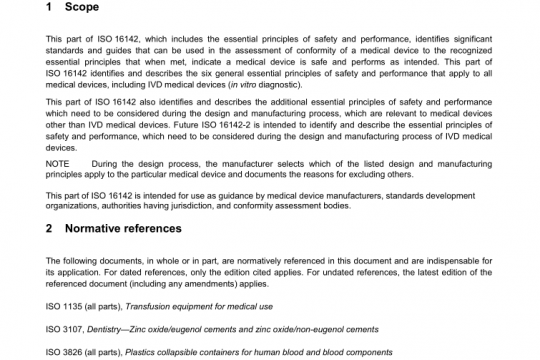AAMI 26722 pdf free download
AAMI 26722 pdf free download.Water treatment equipment for hemodialysis and related therapies.
4.2.1.2 Materials compatility Materials that contact dialysis water (including materials used in piping, storage, and distribution systems) shall not interact chemically or physically with that water so as to adversely affect its purity or quality. Water-contacting surfaces shall be fabricated from non-reactive materials (e.g. plastics) or appropriate stainless steel. The use of materials that are known to cause toxicity in hemodialysis, such as copper, brass, galvanized material, or aluminium, is specifically prohibited at any point beyond the water treatment device used to remove contaminating metal ions, most commonly a reverse osmosis system or a deionizer. The materials of any water treatment devices (including piping, storage, and distribution systems) shall be compatible with the means used to disinfect those devices. Chemicals infused into the water in the pre-treatment section, such as chlorine, acid, flocculants, and complexing agents, shall be adequately removed from dialysis water before they reach any point of use. Monitors or specific test procedures to verifty removal of additives shall be provided. 4.2.1.3 Regenerated or reconstituted devices All devices that are regenerated or reconstituted at a site remote from the dialysis facilit, such as deionizers, shall be disinfected at the time of regeneration or reconstitution so that contaminated water is not reintroduced into the system after regeneration or reconstitution. Separate processes shall be used to ensure no intermixing of devices or their component parts between devices returned from medical or potable water users and devices returned from non- potable water users.4.2.1.4 Disinfection protection When the manufacturer recommends chemical disinfectants [see 6.3 item y)], means shall be provided to restore the equipment and the system in which it is installed, to a safe condition relative to residual disinfectant prior to the dialysis water being used for dialysis applications. When recommending chemical disinfectants, the manufacturer shall also recommend methods for testing for residual levels of the disinfectants. When disinfection is accomplished automatically by chemical disinfectant, including ozone, or by high temperature procedures, activation of the disinfection system shall result in activation of a warning system and measures to prevent patient exposure to an unsafe condition. 4.2.2 Backflow prevention device All water treatment systems should be preceded by a backflow prevention device to isolate the system from the potable water supply according to local plumbing codes. 4.2.3 Tempering valves Tempering valves, if used, shall be sized to accommodate the anticipated range of flow rates of hot and cold water. They shall be ftted with a mechanism to prevent backflow of water into the hot and cold water lines and with a means to monitor the outlet water temperature. 4.2.4 Sediment filters Sediment filters should have an opaque housing or other means to inhibit proliferation of algae. Filters should be fitted with pressure gauges on the inlet and outlet water lines to monitor the pressure drop, OP, across the filter.4.2.6 Softeners Water softeners should be ftted with a mechanism to prevent water containing the high concentrations of sodium chloride used during regeneration from entering the product water line during regeneration. Automatic regeneration can be performed on a volume schedule or on a time schedule. For softeners that are regenerated automatically on a time schedule, the face of the timers used to control the regeneration cycle should be visible to the user. Operating controls shall be positioned so as to minimize inadvertent resetting. 4.2.7 Anion exchange resin tank Anion exchange resin, sometimes referred to as an organic scavenger, can remove organic matter and other contaminants from the source water and protect carbon media from fouling, which can shorten its effective life for chlorine/chloramine removal. If an organic scavenger is installed to protect the carbon media, the scavenger should be installed upstream of the carbon beds. Anion exchange resins can also be used to remove contaminants that might otherwise foul the reverse osmosis membrane.AAMI 26722 pdf download.
Other IEC Standards
-

ANSI AAMI ISO 16142-1 pdf free download – non-IVD medical devices and guidance on the selection of standards
AAMI standards list DOWNLOAD -

ANSI AAMI ISO 16142-2 pdf free download – General essential principles and additional specifc essential principles
AAMI standards list DOWNLOAD


